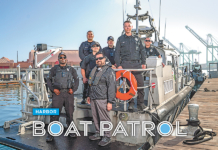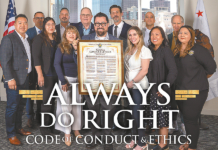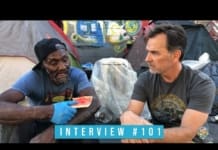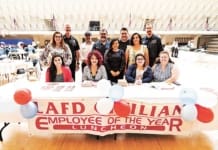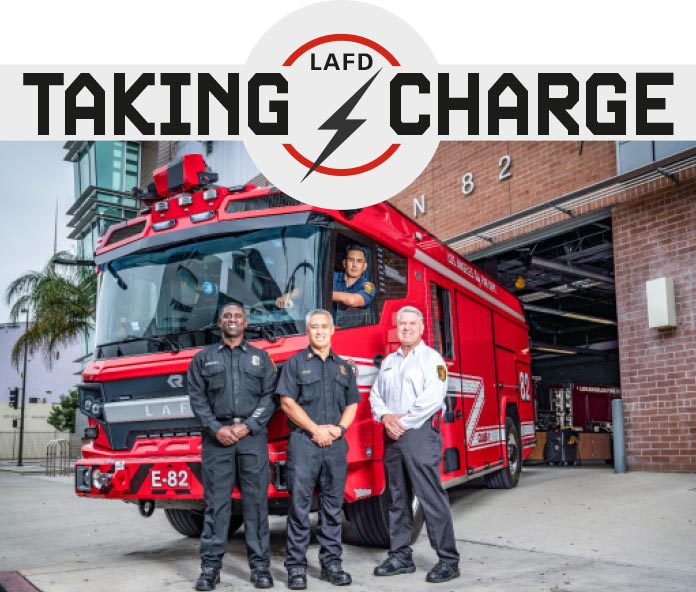 You’ve read that LA has North America’s first all-electric fire engine. (Awesome!) Now read about how it happened.
You’ve read that LA has North America’s first all-electric fire engine. (Awesome!) Now read about how it happened.
iIt’s the first of its kind in North America. It’s the future. And it’s helping protect you and keep you safe.
 It’s the RTX, the LAFD’s customized and specially designed all-electric fire engine, curated by a special team at the LAFD and built by Rosenbauer of Austria.
It’s the RTX, the LAFD’s customized and specially designed all-electric fire engine, curated by a special team at the LAFD and built by Rosenbauer of Austria.
The Fire Dept. is a pioneer, bringing this new technology to fire prevention and safety to North America for the first time.
It’s not just about propelling the fire engine forward on electric power. There’s a lot more to it than that, and these many advantages place the department at the edge of the future.
It wasn’t easy rebuilding the RTX from its European roots into a machine that can deliver all the features the LAFD needs. The process began in 2019 with research into figuring out just what the department wanted in an electric pumper, then creating specs and requirements for its construction, then managing the build, and finally bringing it home and training the crews.
That’s the story you haven’t read about. You can read all about it in this month’s cover story. n
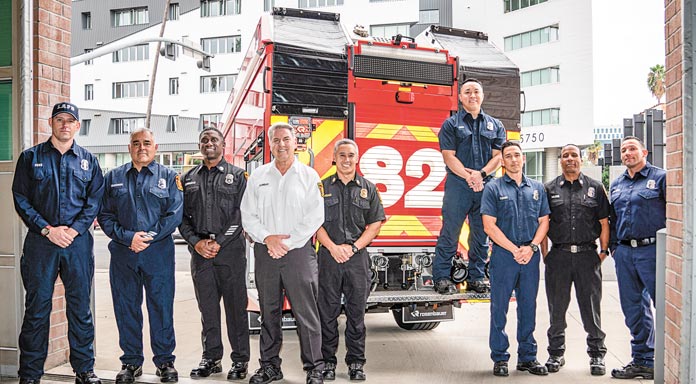
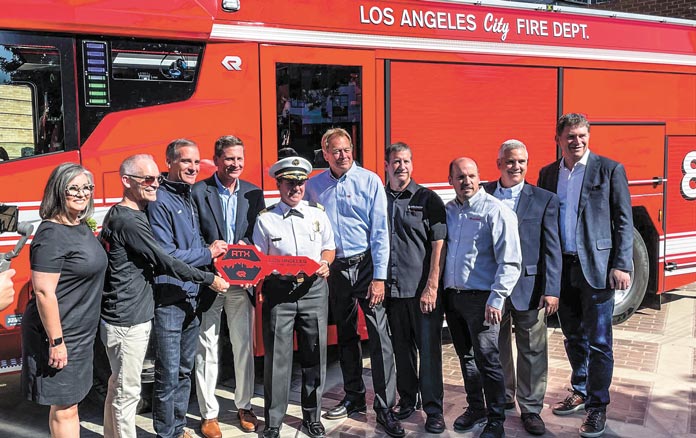

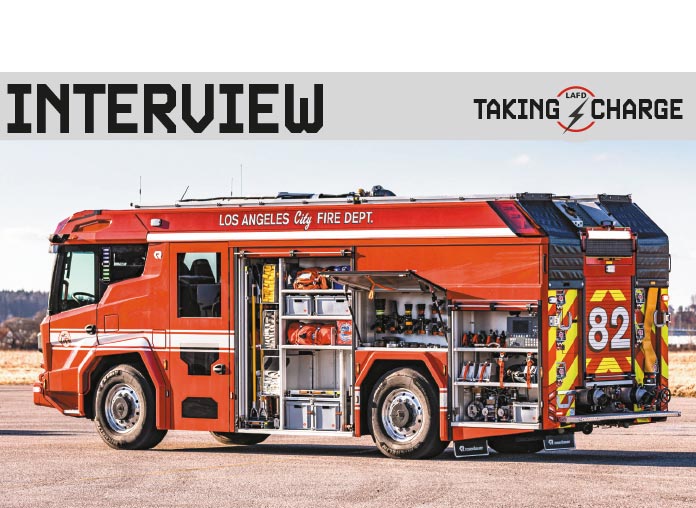
‘Something That Made History’
On Tues., Sept. 27, Club CEO Robert Larios and Alive! editor John Burnes interviewed Michael Dunbar, Equipment Specialist II, Equipment Engineering Unit, 16 years of City service; and Capt. II Darius Cunnigan, Equipment Engineering Unit, Supply and Maintenance, 23 years of City service. They are part of the team that researched, re-engineered and recommended for purchase the LAFD’s first all-electric fire engine, the Rosenbauer RTX. After final work was completed at the LAFD’s Service and Maintenance Worksite in Lincoln Heights, the RTX began service with the LAFD at Fire Station 82 a few weeks before this interview was conducted. The interview took place via Zoom.
Q: Thank you, Michael and Darius, for joining us today to talk about what happened behind the scenes to secure North America’s first all-electric fire truck.

Michael Dunbar: Of course.
Q: Before we begin, we like to ask: How did you get to where you are? What led you to the position you’re in now?
Michael: This is my second career. I started in the automotive industry as a mechanic and made my way up into management. I spent 25 years there, then I came to the Fire Dept. for 16 years. I had to start again as a Mechanic for a short time, and then I worked my way up through supervision at the LAFD. I was then promoted to the LAPD, and then was promoted back to the LAFD in Equipment Engineering.
Q: Do you specialize in any one kind of equipment – ambulances, or engines, or aerials?
Michael: Since I’ve been in Equipment Engineering, I write specifications for anything from gloves to aerial ladder trucks. I’m working on a helicopter spec right now. In general, a little bit of everything.
Q: Darius, same question.
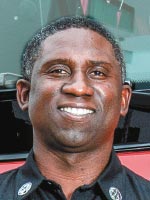
Capt. II Darius Cunnigan: It takes two different kinds of promotions for this position. First of all, you have held the rank as an Engineer or Apparatus Operator, a rated position member, and then at least a Captain I. I was a Firefighter/Paramedic for three-and-a-half years; then an Engineer for ten-and-a-half years; a Captain I for three years; a Captain II/Task Force Commander at Fire Station 94 for three-and-a-half years; and now a Captain II/Special Duty Assignment at the Supply and Maintenance Division’s Equipment Engineering Unit.
Since I’ve been on my current job, I have been involved in testing new tools and equipment, working with the In-Service Unit. I’ve always been interested in apparatus and tools and equipment. I interviewed for the Captain II position at Supply and Maintenance, and I have been here since April 12, 2020. In this position, I’m more open to vendors, and I begin to see how things go from the white board planning perspective to the end user.

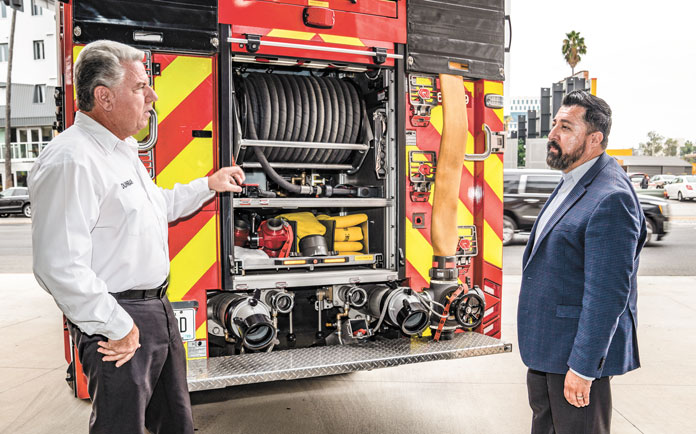
Equipment Engineering
Q: Give us a broad overview – what is the Equipment Engineering Unit all about?
Michael: Equipment Engineering is part of the civilian side.
My role is to research the latest and greatest technology, to see what is reliable and makes the most sense for needs of the department and our members. I then write specifications to develop the products or vehicles for the Fire Dept.’s use.
I look at which manufacturer is suited closest to our needs, then I set the parameters. I write a specification based on that. I then send it out to bid to see who wants to build it at the lowest price.
Q: Is there another unit that’s involved in the purchasing of the new equipment, or is it pretty much centered directly in the Equipment Engineering Unit?
Michael: Our Purchasing Dept. Part of my job is initiating the request for the purchase. Then that goes to our Purchasing section. It goes through them, and then they run the request up to ASB, the higher section in Fire. From there it goes to General Services, which actually produces the purchase orders and puts it out to bid.

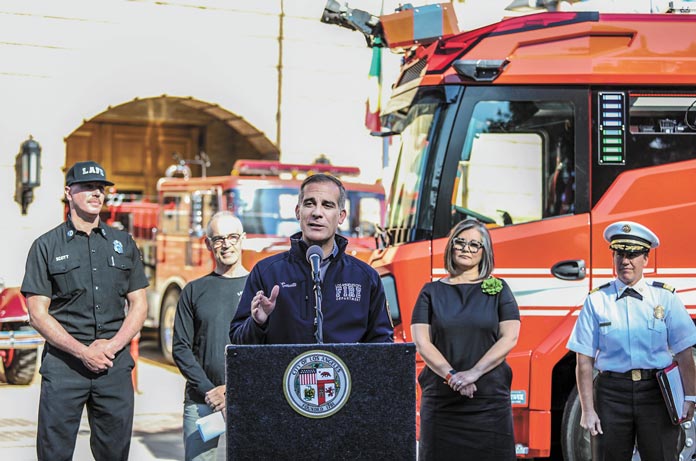
Adapting the RTX
Q: Talk about researching and developing the parameters for the new electric fire truck.
Michael: Sure. Rosenbauer [a manufacturer of fire-fighting equipment based in Austria] came to the LAFD with a concept prototype for an electric Fire Engine they were working on, the CRT. We looked at it and drove it. Mayor Eric Garcetti and Fire Chief [at the time] Ralph Terrazas liked it and thought it would be a good candidate for the new Green program emerging across the nation. Only a couple of companies were working on developing an electric fire truck at that time. We looked at others that were in development at the time that we knew about, and they were all hybrid, basically taking an electric motor and installing it on a conventional Fire truck.
Rosenbauer offered a totally different concept. They had designed a purely electrically driven fire truck, starting as electric from the ground up. It looked nothing like a conventional fire truck and was loaded with innovative ideas. It had all-wheel drive, all-wheel steering, an electric-driven pump with a redundant diesel backup system, and many other innovative ideas.
Q: Right.
Michael Dunbar: The Fire Chief and the Chief of my division at the time, Wade White, came to me and said they and the Mayor liked the vehicle and wanted me to create a specification. I wanted to make it user friendly to our members and for the U.S. style of firefighting. The Rosenbauer concept version was designed for the European way of firefighting, which is very different from ours…
Q: The original Rosenbauer concept needed a lot of changes to make it right for the LAFD.
Michael: Yes. I worked with a couple of Firefighters, Shane Hirsh and Bret Cartier, who would be end users for the electric fire truck. They were very helpful in developing what we thought would be the best, most user-friendly design for use in the field. Later into the project, Capt. Cunnigan came to our unit, the Equipment Engineering Unit, and Chief Richard Fields replaced Chief White over our section. They too had good input into the final specifications as well.
Q: What did you alter from the European design?
Michael: The hose beds required pretty much a redesign of the entire vehicle. Part of the mandate I put on myself was to make sure that this vehicle would do absolutely everything that our current vehicles would do as far as carrying equipment and performing. To achieve that, we had to lengthen the wheelbase of the vehicle by a foot, and then we also lengthened the vehicle behind the rear axle by a foot. And then we created the hose bed. We added a 180-foot hose reel, a tool we’ve never had before on our rigs. It’s a high pressure hose reel; so far in practice, the Firefighters are really liking it. Overall, we were able to get every single tool that we carry onto the RTX with a little bit of room to spare.
Darius: I would describe it as a true unicorn of an apparatus. This project was a completely new drawing of the Rosenbauer model to fit the LAFD standards. We wanted to make everything on the apparatus functional to our current operations and tactics. That’s why it was so important to get all the equipment that we use on the apparatus shipped to Austria. Then we had to decide where the tools and equipment should be mounted for maximum usefulness in an operational way. There was a lot of thought behind the placement of each tool on this apparatus from my perspective and also from the Test Pit Engineer, Bret Cartier, and the In-Service Training Engineer at the time, Shane Hirsh. We all had the outlook to design this apparatus for the end user for practicality.
Q: Right.
Michael: Having a good working relationship with the Rosenbauer engineering team was important. Our Austrian representative, Steve Johns, the one who brought the first CRT out here for a demonstration, has been fantastic and instrumental.
Darius: One of the biggest challenges that we encountered on our end was the mindset change. This was a blank sheet of paper. Some had the mindset to just take an LAFD fire truck that they’re used to and make it electric. But this was more than that – it was ground up. It operates differently, but it does the same functions.
Q: How long was this process from the first time you talked to the Mayor and the Fire Chief?
Michael: I first got involved late in 2019. We were supposed to have a working vehicle by the end of 2020, but obviously COVID hit. We had COVID issues on both sides – the LAFD and with Rosenbauer in Austria.
Q: Right, of course.

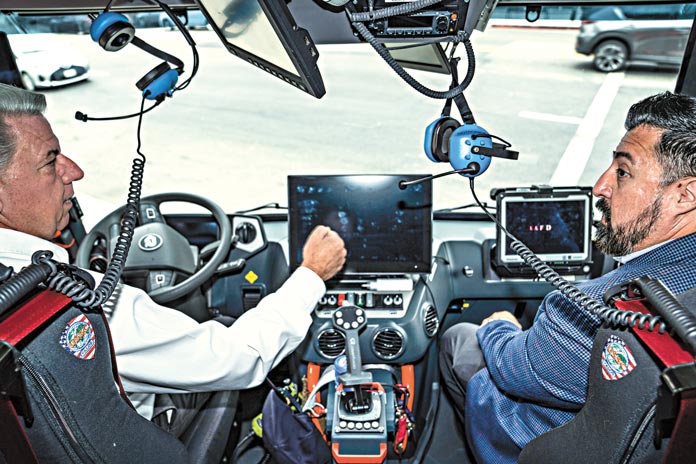
The Future of LAFD Firefighting
Q: Why is this project so important to the LAFD and to the City of Los Angeles?
Darius: From my perspective, I think any time there’s new technology setting standards in the fire service, the LAFD is a trendsetter. We give other departments throughout the nation the opportunity to see how it actually works, or at least our evaluation after testing. Also, emissions – it’s a chance to see if this can lower emissions at incidents. Another reason – we’re a large metropolitan city with busy highways, hillside homes, seaports and high-rise areas – we can see how this apparatus functions in all of them, to test it to the max and see what it can do. At the end of the day, it’s a machine and you can’t make everything perfect, but at least it gives us the opportunity to see if we can change the fire service in a better way or where is it going to take us in the future.
Michael: Like Darius suggested, we have been mandated to have our fleet fully electric by 2035, and the options for vehicles available to do this are very limited. This vehicle is important in trying to meet those goals without sacrificing ability or dependability.
Darius: The other day they ran 22 calls using the RTX and didn’t use any fuel at all. Twenty-two calls, all electric.
Q: That’s incredible. Is any special setup required?
Michael: There is no special setup, but there is some special training for the operators. Most of the special training is to use the electronic pump panel. The members learn this system very quickly, as it’s similar to using your cell phone.
We installed a charging station at Fire Station 82 where the RTX is stationed. We also are having a charging station installed at the main maintenance facility so it can be charged there if it needs to be tested or maintained.
There is no limited use of the vehicle; this is part of what was appealing to LAFD. If the batteries drop below 20 percent while driving or pumping water, there is a small diesel engine on board that automatically turns on to recharge the batteries and will outpace the battery usage even during operation. The diesel engine can run the fire pump even if all the battery supply or electrics would fail for some reason.
Darius: The Equipment Engineering Unit worked with the LAFD Fire Facilities Unit, the Dept. of Water and Power and Rosenbauer to tie in the infrastructure to charge the electric apparatus. Once the power grid was installed, a Heliox DC portable fast charger was hooked up to the Fire Station.
Q: I presume this is the first of many installations.
Darius: Yes, that is the goal. We have newer stations throughout the City that can have the same setup as Fire Station 82 in Hollywood [where the RTX is stationed now]. The wiring and infrastructure to install the electrical grid is already in place for this type of upgrade if we decide to add more electrical vehicles to our fleet.
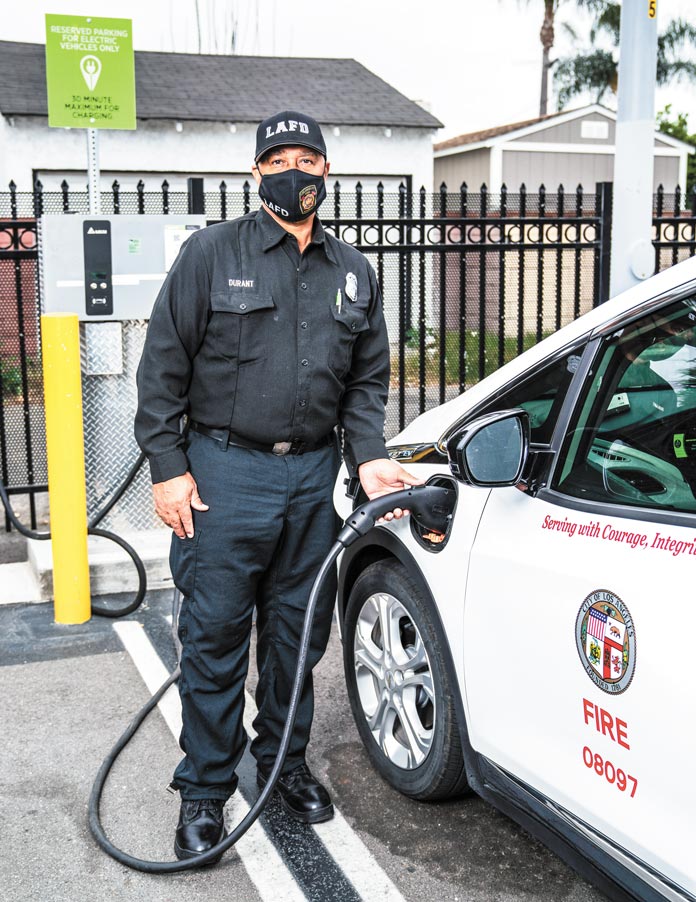
Q: The Fire Dept. has had electric vehicles for a while. We published a photo of a Fire Inspector [Gerald Durant] with an LAFD Chevy Volt, charging it at an LADWP facility. Is the RTX program connected to the other electric vehicles the department is developing?
Michael: The two programs are broadly connected, as they both are part of our going green. Other than that, though, I would say no. This project was separate from the electric vehicles we’re managing for everyday utility use.

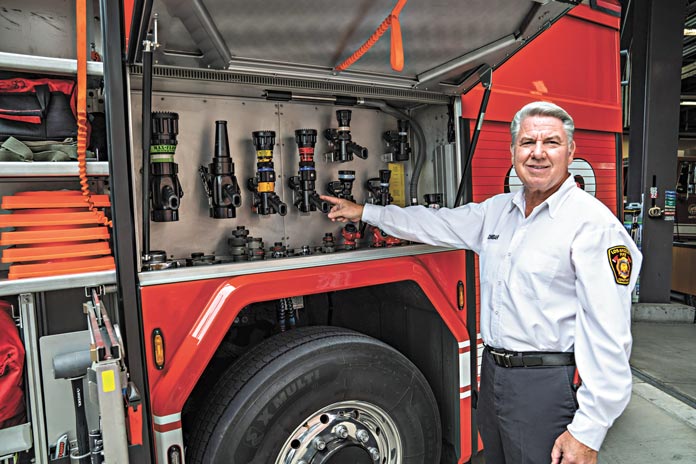
What Success Looks Like
Q: What will success look like, whether it’s at a year with this RTX or down the road in 15 years?
Darius: It’s two parts. Operationally for the end user – is it safe to operate under normal firefighting conditions? What’s the durability of it? The other part is whether other departments will jump on board to purchase the RTX with our adaptations, and whether the LAFD will buy more apparatus like this.
Michael: Success will be when it’s been in operation a while and the members feel that it is performing the same job at the same level or better than the pumpers we currently use. There are a lot of our members who don’t like change and have a negative attitude about this project. When they start using the rig I think they will change their minds. I’ve seen many change their minds after they use it for a short time during training. This too would be a big success.
Q: What have you learned?
Michael: I’ve learned a lot. In the beginning when the Fire Chief and the Mayor came to me with this project, I wasn’t too enthused; I’ve never been a big electric vehicle guy. But I thought, “This is an opportunity to start from scratch.” I knew this was unique, I knew it was going to be something that made history. So I reevaluated. The end product does everything that we expected and more.
Darius: I had to be completely open to a new look and the change to a new style of a fire apparatus. It took me a few months to realize this project was really going to happen. At the time I didn’t really understand that Rosenbauer had already started designing this Electric Vehicle (Euro-spec) ten years prior to coming to the United States and pitching their new concept vehicle. It took me about three to four months before I realized, “Let this concept develop and add what I can to make this project successful.” I kept taking notes, asking a lot of questions, and adding input from my experience as an Engineer. It’s amazing what Rosenbauer was able to engineer and design to build this amazing apparatus.
Q: What are the challenges from here on out?
Michael: There were many challenges in adapting the concept vehicle to fit our way of firefighting and to fit all of the equipment we carry.
Challenges still ahead are creating a charging infrastructure for our entire fleet to go electric and to work out any changes we may decide to make on the next version of the RTX.
Darius: Training the field members; getting everybody up to speed; and having enough Engineers to use this apparatus will be challenging. It’s going to take time.
Michael: I get probably a call a week at least from different agencies throughout the nation asking about this vehicle. People want to know how it’s working out.
Q: What are you working on now?
Michael: We are interested in developing aerial ladder trucks, airport crash rigs, electric ambulances and growing our charging station infrastructure for the mandates ahead.

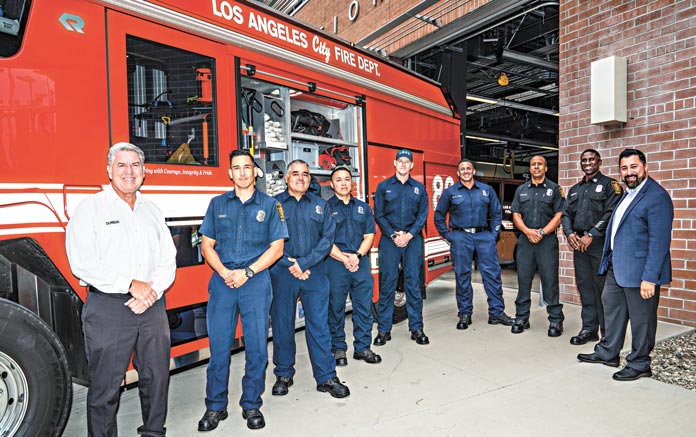
Dedicated to Fire Service
Q: What do you love about what you do with the LAFD and the City of Los Angeles?
Michael: It’s a history-making opportunity. I can always say I was on the ground floor.
Every day is a challenge, and I enjoy solving each challenge. I’m the only person at LAFD who has been involved in developing this RTX with Rosenbauer since the very beginning, so it’s been very satisfying to see it completed. It feels good to know that I was part of the development of this vehicle, not only for the LAFD but for use in the Western Hemisphere. I first started this project in 2019 as a concept, and even with the delays we all suffered from COVID hitting the world, we have succeeded in designing a working electric fire truck at Hollywood Fire Station 82!
When I was first asked to write the LAFD specifications for this electric fire engine, I wasn’t a fan of electric vehicles because for the most part they weren’t truly capable of doing the same job as petroleum-powered vehicles. It’s gratifying to know that this vehicle will perform all of the functions, and even some more, than its diesel-powered equivalent.
Darius: For me it’s an eye-opener. I was an end user at the Fire Station for more than 20 years, and there I just wanted to get in the rig, start it up, take off and run incidents. When I came into this position it changed my whole outlook – I took part in the design process, the purchasing process, the budget behind it, the safety behind it, and better technology. There was some equipment that we were using for a long time. But now some of our equipment is changing probably every five to six years now. Working in the field is rewarding, but I think the reward I get now is because I feel like I’m trying to provide a safer product to the field. There was the idea of why reinvent the wheel? But this makes our job better, safer and more effective. Why not! I’ve never had a problem with change, it’s just convincing members that change is coming.
Q: The future’s here already.
Michael: It is.
Darius: The field members – the Engineers who are actually using the apparatus – are shocked how well it works. What they thought the apparatus would do is totally different in how it works. They’re impressed on the driving capabilities and how well it actually pumps. It’s important for me to get to a real incident and see how it’s doing over a length of time and in a real situation. Over a few years we’ll have a better evaluation. But I think overall this is the start of that serious change, going this way with electric.
Q: Michael, did you ever think when you were a teenager in the driveway with the hood open and your wrenches in your hand, that you’d be doing this?
Michael: I didn’t. I love mechanical things. I rebuilt my first V8 engine when I was eight years old with my dad’s help. I’ve had a love for mechanical things right from the beginning, but I didn’t expect to be here. On our last field trip, Darius and I were talking about exactly that. It’s been a great opportunity.
Q: Gentlemen thank you so much for your service to the City of LA, and for looking at the future and helping us get there.
Darius: Thank you.
Michael: Thank you. Thanks for the opportunity. n
|
BEHIND THE SCENE
|


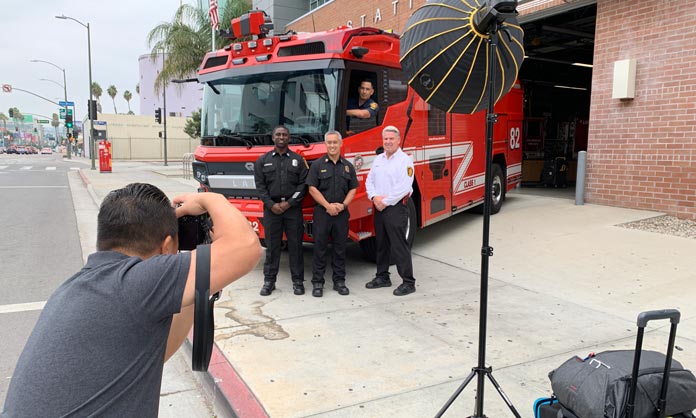 Xxxxxxxxxxxx
Xxxxxxxxxxxx

